review housed at http://www.tinwhistler.com/music/reviews.asp
Jubilee S4 Series D
(Review written April 2005)
Preface
In November of 2004, Daniel Bingamon asked me if I’d like to review one of his whistles. I was most definitely interested! There are a few well-known makes of instruments out there, such as Copeland, Clarke, Generation, etc. It’s not hard to find information out about them. But then there are lesser-known instruments also out there: Tully, Jubilee, Swayne, etc. You can find some information if you look, but there’s not a wealth of it. So I’m always excited to get my hands on an instrument that may be a little off the beaten path, and help people find out if it’s for them.
At a Glance
Whistle Reviewed: Jubilee S4 Series D (“Saturday Night Special”)
Models Available: A variety of models in different keys and even custom scales (such as the Ahava Rabba scale).
Construction: Red Brass tube, acetal mouthpiece.
Price at time of review: $55.00 US dollars
Available From: Jubilee Music Instrument Co.
How Acquired: Product Sample from Daniel Bingamon.
Bottom Line: Strong tone, above average volume. Chiffy, with plenty of backpressure. Holes a bit unevenly drilled.
Appearance/Construction
This is an interesting whistle. The whistle is sputter-sprayed with shellac, to give it a bit of a texture to it, which also has the added benefit of keeping any brass smell off your fingers.
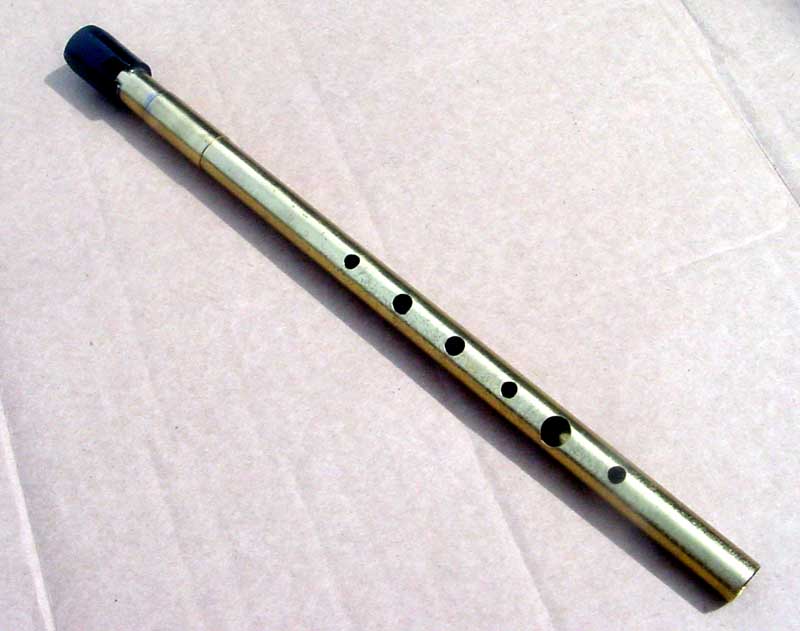
Here’s the full whistle. It looks a lot like the pictrures of whistles that I’ve seen on the Jubilee website. You can see the simple brass tube, and the black acetal (Delrin) fipple plug. You can see a bit of the shellac texturing here, too.
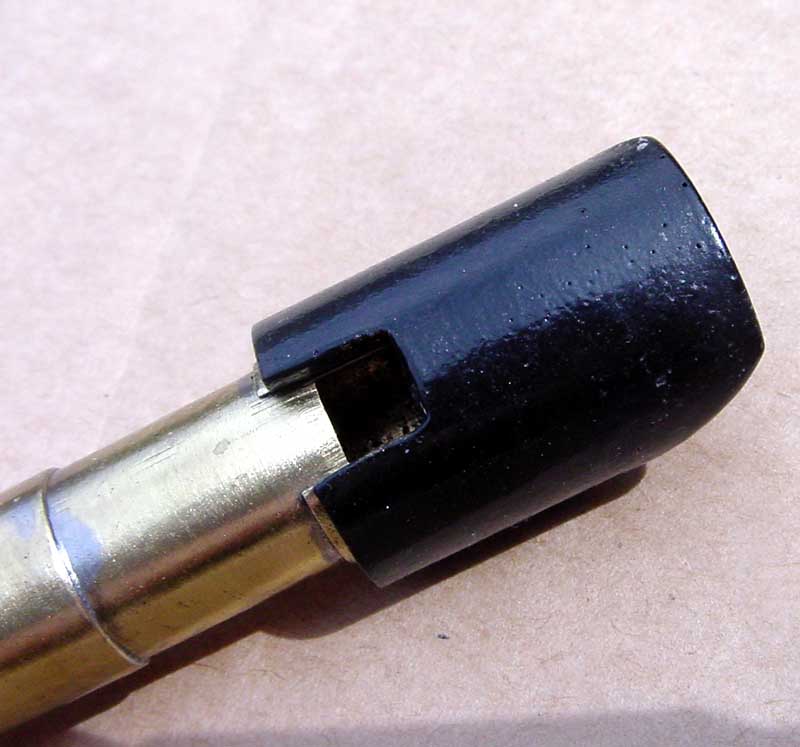
Here’s a closeup of the mouthpiece. Everything is soldered together, and doesn’t feel loose. You can see the labium ramp and the headpiece. The ramp appears to have shaping done to it. The windway exit is actually raised around the ramp in a “wall”, much like Copeland low D’s. More on that in a bit. The mouthpiece itself looked a little weird to me for Delrin. I’m not used to seeing it with that particular texture. And then I noticed that Daniel has an interesting way of smoothing out the Delrin texture using a torch, which you can read on the Chiff and Fipple message board.
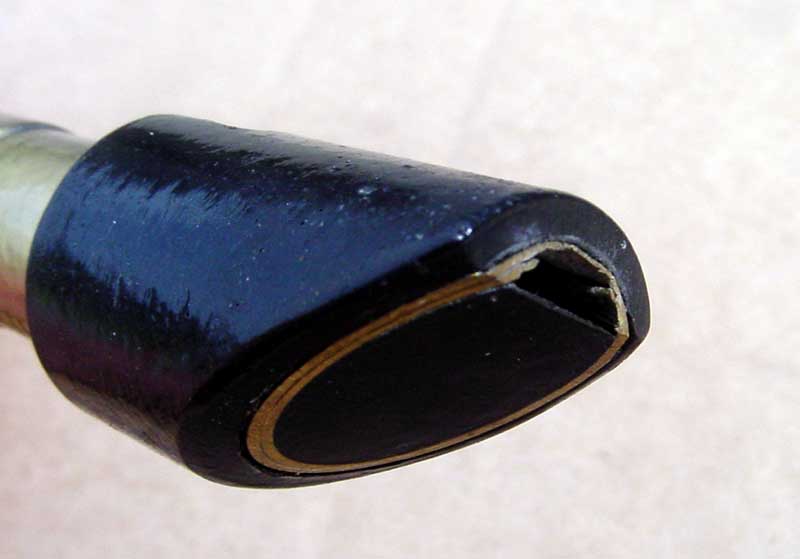
Here’s another angle on the mouthpiece, showing the fipple area. The windway channel appears to be a little uneven here. I’m not a whistle-smith, but I wonder if some of the chiffy windiness of this whistle is caused here.

Here’s a close-up of a couple of the finger holes, which gives you a better view of the shellac texturing as well. I like the shellac..it gives a nice solid grip to the instrument. The tone holes are a little uneven, but that’s not usually a big deal to me unless they have burrs, or are out of alignment. My only concern here is the E hole, which is the far left hole in the picture. It’s already pretty wide on the barrel, so because it’s a little off-center to the left, it actually goes a good way around that direction. Here’s a pic:
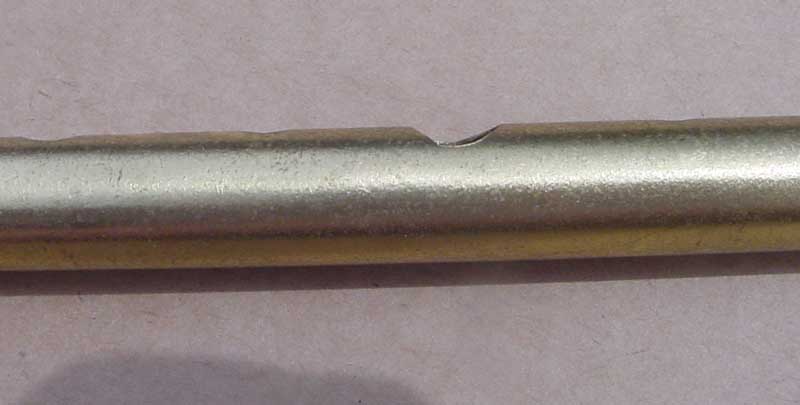
Here you can see where the E hole goes much further around to the left than any other hole. It doesn’t go that far around on the right. If I play this with my normal grip, I end up leaving a little hair of a gap on this hole, causing the whistle to squeak. To get a good seal on this hole, I have to make sure my finger curves around the barrel slightly to keep from having a little air leak. It’s not that hard to deal with, but if I had bought this whistle, I would likely send it back and ask for a new body.
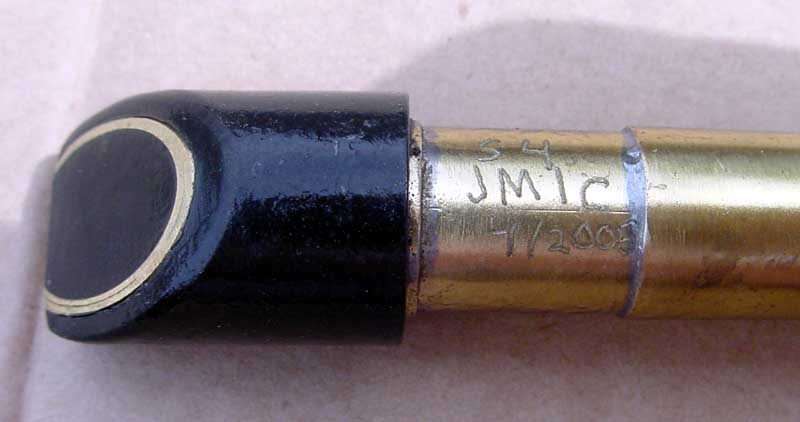
Here’s the maker mark and date. JMIC seems to stand for Jubilee Music Instrument Company, and we have the date of manufacture and S4 for the type of whistle. You can also see here the soldered tuning slide, which I didn’t make a close-up of. It’s a simple metal-within-metal affair, and there’s not much I can say about it, really. It’s unobtrusive, is well soldered, gives about an inch of tuning play, and performs it’s job well. It isn’t too tight, and it isn’t too loose. I’ve paid much more for instruments that had tuning slides that didn’t work this well in practice.
Playing Characteristics
This whistle had a very strong tone, with a hint of that Feadog-like complexity, and a hint of tweaked-Shaw chiff and windiness. After playing the whistle, I had to go back and look at the mouthpiece to see if I could figure out why it sounded so strong in the bell note. Then I noted the raised ‘walls’ around the ramp and figured that they must have something to do with it. I thought to myself “Well it’s a thick mouthpiece, and it seems to have the coincidental effect of working like the walls on a Copeland low D”. Later, looking at the Jubilee instrument site, I noticed that they mention the walls too, so the mouthpiece design is no happy accident!
Sound clip of the whistle:
Fraher’s Jig
Volume: A little louder than average. It was really too loud to play in the second octave at the restaurant the night I took my wife out to dinner and a movie (wheras my old Hoover, or even a Sweetone might have been OK). If you’ve read some of my other reviews, you may know that the Friday Irish session I attend is a loud affair with 10-15 musisians, in a very large, full bar. Nothing less than an Abell or Copeland can be heard at all in that environment, and I’ve even been asked to play something that could be heard beter than my Sweetheart. The S4 wouldn’t quite make it in that environment, but is definitely a little loud for a really quiet session.
Responsiveness: This whistle is nice and responsive. I was able to play all manner of tunes on it without problems.
C-Natural: OXXOOO produces a C-natural that’s in tune with the proper breath pressure. But you can also really push it around with your breath, making it up to 40 cents sharp and up to 60-70 cents flat! That’s probably more variation than I’ve ever gotten out of a whistle from breath pressure.
Tuning: This whistle is in tune, when blown with the proper breath control. The first octave D is a little flat, about 7 cents flat when compared to the rest of the instrument, and it has to be pushed near the octave jump to bring it into line. On the rest of the notes, this instrument has a wide variation in tuning based on breath, and much like the C-natural, range from 20-30 cents sharp to a 50-60 cents flat. If it were a little more centered in the breathing range, I think it’d be even better, but it still provides a lot of room for dynamic pitch changes with the breath the way it is.
Hole Size and placement: The holes are set fairly evenly along the body. Except for the unfortunate condition of the E hole that I mention above, the holes are nicely sized and easy to seal.
Air volume requirements: This whistle is pretty average on the breath-volume requirements. It plays just like an average whistle should.
Air pressure pressure requirements: The whistle has some pronounced backpressure in the 2nd octave, and there’s quite a bit of a jump between octaves as far as pressure is concerned. You can’t be shy about hitting the second octave notes, or you won’t get there cleanly. If you don’t like a lot of push in your instruments, you probably won’t like this one. On the other hand, if you do like a lot of push, you can really lean into this instrument and wail in the second octave.
Clogging: This instrument has average wetness, but never clogged up on me. I’d play for 20-30 minutes, and the mouthpiece would start feeling wet. I’d blow it out and play until my lip felt wet again. But the whistle itself never went out on me or had any tone degradation, which is nice.
Summary
I wouldn’t call this whistle a work of art..But then again, it’s not a $300 whistle. If you’re looking for a sleek panther of a whistle, with fine lines and silver trim, save up and buy an Abell. The Jubilee S4, you buy for the sound. This whistle has a strong, complex tone, characteristic of both styles of “old school” whistles: The Shaw-like chiffiness with the Feadog-like complexity. I also wouldn’t call this a beginner’s instrument: there’s some breath control you should learn before you take on one that is capable of this much variation, but once you are comfortable with this aspect of playing, you should be able to control it without too much difficulty.